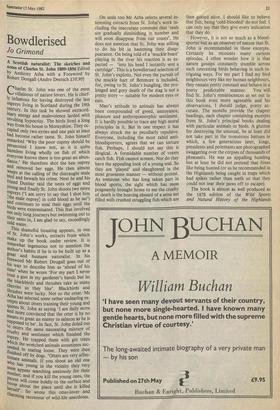Bowdlerised
Jo Grimond
A Scottish naturalist: The sketches and notes of Charles St. John 1809-1856 Edited by Anthony Atha with a Foreword by Robert Dougall (Andre Deutsch £10.95)
Charles St. John was one of the most , villainous of nature lovers. He is chief- ly infamous for having destroyed the last ospreys living in Scotland during the 19th century. In this task he showed extraord-
inary energy and malevolence larded with revolting hypocrisy. The birds lived a long Way from his house in Morayshire. They oc- cupied only two eyries and one pair at least had become rather tame. St. John himself remarked 'Why the poor osprey should be Persecuted I know not, as it is quite harmless living wholly on fish of which everyone knows there is too great an abun- dance.' He therefore shot the hen osprey and removed her eggs. He then almost Weeps at the calling of the distraught male bird and bewails his crime. Next he and his friend Dunbar raid the nests of eggs and
Young and finally St. John shoots two more ospreys ('I am sorry to say that I shot him [the male osprey] in cold blood as he sat') and continues to steal their eggs until the birds were exterminated. This feat involved not only long journeys but swimming out to their nests in, I am glad to say, exceedingly cold water.
This shameful boasting appears, in one of St. John's works, extracts from which make up the book under review. It is sornewhat ingenuous not to mention the author's habits if he is to be built up as a great and humane naturalist. In his foreword Mr Robert Dougall goes out of
time' way to describe him as 'ahead of his Lime, when he wrote 'For my part I never
trust a gun in my gardener's hands but let the blackbirds and thrushes take as many cherries as they like'. Blackbirds and thrushes were lucky. Not so the otter. Mr Atha has selected some rather endearing ex- cerpts about otters training their young and quotes St. John as saying 'I am daily more and more convinced that the otter is by no means so great an enemy to salmon as he is to to be'. In fact, St. John doled out ro otters the same nauseating mixture of Cruelty and sentiment which finished the Osprey. He trapped them with gin traps
which the wretched animals sometimes suc-
c_eeded in tearing loose. They were then finished off by dogs. 'Otters are very affec- tionate animals. If you shoot an old one
soon has young in the vicinity they very soon appear searching anxiously for their mother; and if you kill the young ones, the parent will come boldly to the surface and hnover about the place until she is killed
nie,rself'. So wrote this otter-lover and 'arming raconteur of wild-life anecdotes.
On seals too Mr Atha selects several in- teresting extracts from St. John's work in- cluding the inaccurate comment that 'seals are gradually diminishing in number and will soon disappear from our coasts'. He does not mention that St. John was willing to do his bit in hastening their disap- pearance. On being told of a 'muckle beast' playing in the river his reaction is as ex- pected — 'into his head I instantly sent a cartridge'. This is a bowdlerised selection of St. John's exploits. Not even the pursuit of the muckle hart of Benmore is included, for, owing to St. John's bungling, the pro- longed and gory death of the stag is not a pretty story — suitable for modern eyes or ears.
Man's attitude to animals has always been compounded of greed, annoyance, pleasure and anthropomorphic sentiment. It is hardly possible to trace any high moral principles in it. But in one respect it has always struck me as peculiarly repulsive. Everyone, including the most rabid anti- bloodsporters, agrees that we can torture fish. Perhaps, I should not say this is illogical. A formidable number of voters catch fish. Fish cannot scream. Nor do they have the appealing look of a young seal. So they are 'played' and slaughtered in the most gruesome manner — without protest. As someone who has long taken part in blood sports, the sight which has most poignantly brought home to me the cruelty of death is the heaving aboard of a seine net filled with crushed struggling fish which are then gutted alive. I should like to believe that fish, being `cold-blooded' do not feel. I can only say that they give every indication that they do.
However, it is not so much as a blood- sporter but as an observer of nature that St. John is recommended in these excerpts. Certainly he recounts many curious episodes. I often wonder how it is that nature gossips constantly stumble across such interesting birds behaving in such in- triguing ways. For my part I find my bird neighbours very like my human neighbours, they remain pretty constant and behave in a pretty predictable manner. You will find St. John's reminiscences as set out in this book even more agreeable and his observations, I should judge, pretty ac- curate. The months provide the chapter headings, each chapter containing excerpts from St. John's principal books dealing with particular animals or birds. A glutton for destroying the unusual, he at least did not take part in the monstrous battues in which, a few generations later, kings, presidents and potentates are photographed swaggering over the corpses of thousands of pheasants. He was an appalling humbug but at least he did not pretend that foxes like being hunted (or as he recommended in the Highlands being caught in traps which had spikes rather than teeth so that they could not tear their paws off to escape).
The book is almost as well produced as the 1878 edition of the Wild Sports and Natural History of the Highlands.






































 Previous page
Previous page